Students of architecture designed bird homes that can be installed in buildings or incorporated in planning of highrises as urbanisation is taking away the living place of the avian species.
A one-day workshop at Jadavpur University had participants from architecture schools from the city.
Sixty students from Sister Nivedita University, Techno India University, Amity University, Calcutta, Om Dayal College of Architecture, Uluberia and Jadavpur University participated in Pakhighar, an initiative with waste materials.
The challenges for birds amidst the urbanisation is to find a place to nest or perch more because the architectural design of buildings have changed over the years, said one of the organisers.
“There has been a change in architectural design of buildings. We rarely find space for ventilation because rooms are air conditioned. Even though human beings could be emotionally connected to birds, when it comes to sharing space there is a human-bird conflict. The space for ventilation was often used by birds and people in buildings would object to that,” said Madhumita Roy, professor, department of architecture, Jadavpur University.
“There is a need for co-existence and architectural plans can be sensitive to that,” she said.
The workshop was Roy’s brainchild and it was a joint initiative of the architecture department of Jadavpur University; I am Kolkata, a CSR initiative of Merlin Group and Kolkata Society for Cultural Heritage on Friday, an organisation, on “conceptualising habitats for bird shelter in urban areas and building a prototype with appropriate organic/inorganic waste materials”.
The idea came to Roy while she was doing a research project in 2019 on the impact of urbanisation on bird habitats in Calcutta.
“With the rise in population, the skyline is changing and vegetation is reducing. After completing the research I wanted to do a series of awareness programmes and this workshop is part of that,” said Roy.
But Roy included not just architecture students but those from other streams as well. Each team of three students was mentored by a professional architect.
“The need of the hour is to look for some bird-friendly architecture in our buildings so that avian species and human population can live in harmony. We will focus on biophilic architecture in our projects and try to incorporate some bird-friendly habitats from this workshop in our projects,” said Saket Mohta, managing director, Merlin Group.
